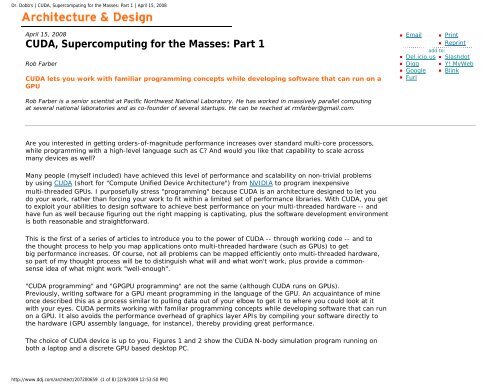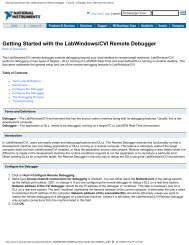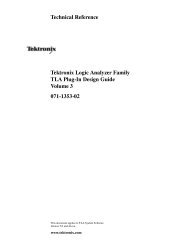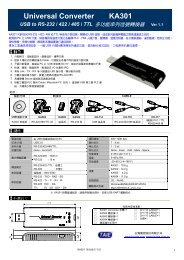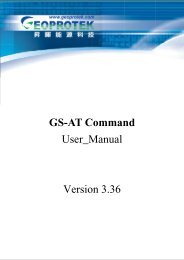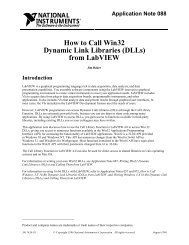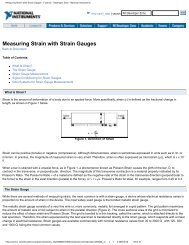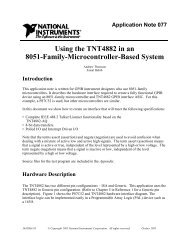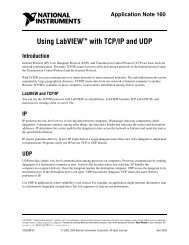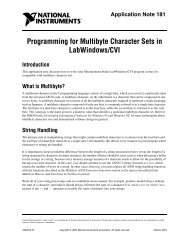Dr. Dobb's | CUDA, Supercomputing for the Masses: Part 1 | April 15 ...
Dr. Dobb's | CUDA, Supercomputing for the Masses: Part 1 | April 15 ...
Dr. Dobb's | CUDA, Supercomputing for the Masses: Part 1 | April 15 ...
Create successful ePaper yourself
Turn your PDF publications into a flip-book with our unique Google optimized e-Paper software.
<strong>Dr</strong>. <strong>Dobb's</strong> | <strong>CUDA</strong>, <strong>Supercomputing</strong> <strong>for</strong> <strong>the</strong> <strong>Masses</strong>: <strong>Part</strong> 1 | <strong>April</strong> <strong>15</strong>, 2008<br />
<strong>April</strong> <strong>15</strong>, 2008<br />
<strong>CUDA</strong>, <strong>Supercomputing</strong> <strong>for</strong> <strong>the</strong> <strong>Masses</strong>: <strong>Part</strong> 1<br />
Rob Farber<br />
<strong>CUDA</strong> lets you work with familiar programming concepts while developing software that can run on a<br />
GPU<br />
Email<br />
Del.icio.us<br />
Digg<br />
Google<br />
Furl<br />
add to:<br />
Print<br />
Reprint<br />
Slashdot<br />
Y! MyWeb<br />
Blink<br />
Rob Farber is a senior scientist at Pacific Northwest National Laboratory. He has worked in massively parallel computing<br />
at several national laboratories and as co-founder of several startups. He can be reached at rmfarber@gmail.com.<br />
Are you interested in getting orders-of-magnitude per<strong>for</strong>mance increases over standard multi-core processors,<br />
while programming with a high-level language such as C And would you like that capability to scale across<br />
many devices as well<br />
Many people (myself included) have achieved this level of per<strong>for</strong>mance and scalability on non-trivial problems<br />
by using <strong>CUDA</strong> (short <strong>for</strong> "Compute Unified Device Architecture") from NVIDIA to program inexpensive<br />
multi-threaded GPUs. I purposefully stress "programming" because <strong>CUDA</strong> is an architecture designed to let you<br />
do your work, ra<strong>the</strong>r than <strong>for</strong>cing your work to fit within a limited set of per<strong>for</strong>mance libraries. With <strong>CUDA</strong>, you get<br />
to exploit your abilities to design software to achieve best per<strong>for</strong>mance on your multi-threaded hardware -- and<br />
have fun as well because figuring out <strong>the</strong> right mapping is captivating, plus <strong>the</strong> software development environment<br />
is both reasonable and straight<strong>for</strong>ward.<br />
This is <strong>the</strong> first of a series of articles to introduce you to <strong>the</strong> power of <strong>CUDA</strong> -- through working code -- and to<br />
<strong>the</strong> thought process to help you map applications onto multi-threaded hardware (such as GPUs) to get<br />
big per<strong>for</strong>mance increases. Of course, not all problems can be mapped efficiently onto multi-threaded hardware,<br />
so part of my thought process will be to distinguish what will and what won't work, plus provide a commonsense<br />
idea of what might work "well-enough".<br />
"<strong>CUDA</strong> programming" and "GPGPU programming" are not <strong>the</strong> same (although <strong>CUDA</strong> runs on GPUs).<br />
Previously, writing software <strong>for</strong> a GPU meant programming in <strong>the</strong> language of <strong>the</strong> GPU. An acquaintance of mine<br />
once described this as a process similar to pulling data out of your elbow to get it to where you could look at it<br />
with your eyes. <strong>CUDA</strong> permits working with familiar programming concepts while developing software that can run<br />
on a GPU. It also avoids <strong>the</strong> per<strong>for</strong>mance overhead of graphics layer APIs by compiling your software directly to<br />
<strong>the</strong> hardware (GPU assembly language, <strong>for</strong> instance), <strong>the</strong>reby providing great per<strong>for</strong>mance.<br />
The choice of <strong>CUDA</strong> device is up to you. Figures 1 and 2 show <strong>the</strong> <strong>CUDA</strong> N-body simulation program running on<br />
both a laptop and a discrete GPU based desktop PC.<br />
http://www.ddj.com/architect/207200659 (1 of 8) [2/9/2009 12:53:50 PM]
<strong>Dr</strong>. <strong>Dobb's</strong> | <strong>CUDA</strong>, <strong>Supercomputing</strong> <strong>for</strong> <strong>the</strong> <strong>Masses</strong>: <strong>Part</strong> 1 | <strong>April</strong> <strong>15</strong>, 2008<br />
Figure 1: nBody Astrophysics Simulation running on a Quadro FX 570M enabled laptop.<br />
http://www.ddj.com/architect/207200659 (2 of 8) [2/9/2009 12:53:50 PM]
<strong>Dr</strong>. <strong>Dobb's</strong> | <strong>CUDA</strong>, <strong>Supercomputing</strong> <strong>for</strong> <strong>the</strong> <strong>Masses</strong>: <strong>Part</strong> 1 | <strong>April</strong> <strong>15</strong>, 2008<br />
Figure 2: nBody Astrophysics Simulation running on a GeForce 8800 GTS 512MB<br />
enabled desktop<br />
Can <strong>CUDA</strong> really increase application per<strong>for</strong>mance by one to two orders of magnitude -- or is all this hype ra<strong>the</strong>r<br />
than reality<br />
<strong>CUDA</strong> is a fairly new technology but <strong>the</strong>re are already many examples in <strong>the</strong> literature and on <strong>the</strong><br />
Internet highlighting significant per<strong>for</strong>mance boosts using current commodity GPU hardware. Tables 1 and 2<br />
http://www.ddj.com/architect/207200659 (3 of 8) [2/9/2009 12:53:50 PM]
<strong>Dr</strong>. <strong>Dobb's</strong> | <strong>CUDA</strong>, <strong>Supercomputing</strong> <strong>for</strong> <strong>the</strong> <strong>Masses</strong>: <strong>Part</strong> 1 | <strong>April</strong> <strong>15</strong>, 2008<br />
show summaries posted on <strong>the</strong> NVIDIA and Beckman Institute websites. At <strong>the</strong> heart of <strong>CUDA</strong> is <strong>the</strong> ability<br />
<strong>for</strong> programmers to keep thousands of threads busy. The current generation of NVIDIA GPUs can efficiently support<br />
a very large number of threads, and as a result <strong>the</strong>y can deliver one to two orders of magnitude<br />
per<strong>for</strong>mance increase in application per<strong>for</strong>mance. These graphics processors are widely available to anyone at<br />
almost any price point. Newer boards will expand <strong>CUDA</strong>'s capabilities by providing greater memory<br />
bandwidth, asynchronous data transfer, atomic operations, and double-precision floating point arithmetic<br />
among many hardware improvements. Look <strong>for</strong> <strong>the</strong> <strong>CUDA</strong> software environment to expand as <strong>the</strong> technology<br />
evolves and we eventually lose <strong>the</strong> distinction between GPUs and "many-core" processors. As developers, we have<br />
to anticipate that applications with many thousands of active threads will become common-place and look <strong>for</strong><br />
<strong>CUDA</strong> to run on many plat<strong>for</strong>ms, including general-purpose processors.<br />
Example<br />
Applications<br />
URL<br />
Application<br />
Speedup<br />
Seismic Database http://www.headwave.com 66x to 100x<br />
Mobile Phone<br />
Antenna Simulation<br />
http://www.acceleware.com<br />
45x<br />
Molecular Dynamics http://www.ks.uiuc.edu/Research/vmd 21x to 100x<br />
Neuron Simulation http://www.evolvedmachines.com 100x<br />
MRI processing http://bic-test.beckman.uiuc.edu 245x to 4<strong>15</strong>x<br />
Atmospheric Cloud<br />
Simulation<br />
http://www.cs.clemson.edu/~jesteel/clouds.html<br />
50x<br />
Table 1: NVIDIA summary from www.nvidia.com/object/IO_43499.html<br />
GPU Per<strong>for</strong>mance Results, March 2008<br />
GeForce8800GTX w/ <strong>CUDA</strong> 1.1, <strong>Dr</strong>iver 169.09<br />
Calculation / Algorithm Algorithm class Speedup vs. Intel<br />
QX6700 CPU<br />
http://www.ddj.com/architect/207200659 (4 of 8) [2/9/2009 12:53:50 PM]
<strong>Dr</strong>. <strong>Dobb's</strong> | <strong>CUDA</strong>, <strong>Supercomputing</strong> <strong>for</strong> <strong>the</strong> <strong>Masses</strong>: <strong>Part</strong> 1 | <strong>April</strong> <strong>15</strong>, 2008<br />
Fluorescence<br />
microphotolysis<br />
Iterative matrix / stencil<br />
12x<br />
Pairlist calculation <strong>Part</strong>icle pair distance test 10x to 11x<br />
Pairlist update <strong>Part</strong>icle pair distance test 5x to <strong>15</strong>x<br />
Molecular dynamics<br />
nonbonded <strong>for</strong>ce<br />
calculation<br />
Cutoff electron density<br />
sum<br />
N-body cutoff <strong>for</strong>ce<br />
calculations<br />
<strong>Part</strong>icle-grid w/ cutoff<br />
10x to 20x<br />
<strong>15</strong>x to 23x<br />
Cutoff potential summation <strong>Part</strong>icle-grid w/ cutoff 12x to 21x<br />
Direct Coulomb summation <strong>Part</strong>icle-grid 44x<br />
Table 2: Beckman Institute table from www.ks.uiuc.edu/Research/vmd/publications/<br />
siam2008vmdcuda.pdf<br />
As a scientist at Los Alamos National Laboratory in <strong>the</strong> 1980s, I had <strong>the</strong> pleasure of working with <strong>the</strong><br />
massively parallel 65,536 processor Thinking Machines supercomputers. <strong>CUDA</strong> has proved to be a natural<br />
framework to again start working in a modern massively-parallel (i.e., highly-threaded) environment. Per<strong>for</strong>mance<br />
is clearly <strong>the</strong>re. One of my production codes, now written in <strong>CUDA</strong> and running on NVIDIA GPUs, shows both<br />
linear scaling and a nearly two orders of magnitude speed increase over a 2.6-Ghz quad-core Opteron system.<br />
<strong>CUDA</strong>-enabled graphics processors operate as co-processors within <strong>the</strong> host computer. This means that each GPU<br />
is considered to have its own memory and processing elements that are separate from <strong>the</strong> host computer.<br />
To per<strong>for</strong>m useful work, data must be transferred between <strong>the</strong> memory space of <strong>the</strong> host computer and <strong>CUDA</strong><br />
device(s). For this reason, per<strong>for</strong>mance results must include IO time to be in<strong>for</strong>mative. Colleagues have also<br />
referred to <strong>the</strong>se as "Honest Flops" because <strong>the</strong>y more accurately reflect <strong>the</strong> per<strong>for</strong>mance applications will deliver<br />
in production.<br />
I claim that a one or two orders of magnitude per<strong>for</strong>mance increase over existing technology is a disruptive<br />
change that can dramatically alter some aspects of computing. For example, computational tasks that<br />
previously would have taken a year can now complete in a few days, hour long computations suddenly<br />
become interactive because <strong>the</strong>y be completed in seconds with <strong>the</strong> new technology, and previously intractable<br />
real-time processing tasks now becomes tractable. Finally, lucrative opportunities can present <strong>the</strong>mselves<br />
<strong>for</strong> consultants and engineers with <strong>the</strong> right skill set and capabilities to write highly-threaded (or massively<br />
parallel) software. What about you How can this type of computing capability benefit your career, applications<br />
or real-time processing needs<br />
http://www.ddj.com/architect/207200659 (5 of 8) [2/9/2009 12:53:50 PM]
<strong>Dr</strong>. <strong>Dobb's</strong> | <strong>CUDA</strong>, <strong>Supercomputing</strong> <strong>for</strong> <strong>the</strong> <strong>Masses</strong>: <strong>Part</strong> 1 | <strong>April</strong> <strong>15</strong>, 2008<br />
Getting started costs nothing and is as easy as downloading <strong>CUDA</strong> from <strong>the</strong> <strong>CUDA</strong> Zone homepage (look <strong>for</strong><br />
"Get <strong>CUDA</strong>"). After that, follow <strong>the</strong> installation instructions <strong>for</strong> your particular operating system. You don't even<br />
need a graphics processor because you can start working right away by using <strong>the</strong> software emulator to run on<br />
your current laptop or workstation. Of course, much better per<strong>for</strong>mance will be achieved by running with a<br />
<strong>CUDA</strong>-enabled GPU. Perhaps your computer already has one. Check out <strong>the</strong> "<strong>CUDA</strong>-enabled GPUs" link on <strong>the</strong><br />
<strong>CUDA</strong> Zone homepage to see. (A <strong>CUDA</strong>-enabled GPU includes shared on-chip memory and thread management.)<br />
If purchasing a new graphics processor card, I suggest following this article series because I will discuss how<br />
various hardware characteristics (such as memory bandwidth, number of registers, atomic operations, and so on)<br />
will affect application per<strong>for</strong>mance, which will assist you in selecting <strong>the</strong> appropriate hardware <strong>for</strong> your<br />
application. Also, <strong>the</strong> <strong>CUDA</strong> Zone <strong>for</strong>ums provide a wealth of in<strong>for</strong>mation on all things <strong>CUDA</strong>, including<br />
discussions about what hardware to purchase.<br />
Once installed, <strong>the</strong> <strong>CUDA</strong> Toolkit provides a reasonable set of tools <strong>for</strong> C language application development.<br />
This includes:<br />
●<br />
●<br />
●<br />
●<br />
●<br />
●<br />
The nvcc C compiler<br />
<strong>CUDA</strong> FFT and BLAS libraries <strong>for</strong> <strong>the</strong> GPU<br />
A profiler<br />
An alpha version (as of March 2008) of <strong>the</strong> gdb debugger <strong>for</strong> <strong>the</strong> GPU<br />
<strong>CUDA</strong> runtime driver (now also available in <strong>the</strong> standard NVIDIA GPU driver)<br />
<strong>CUDA</strong> programming manual<br />
The nvcc C compiler does most of <strong>the</strong> work in converting C code into an executable that will run on a GPU or<br />
<strong>the</strong> emulator. Happily, assembly-language programming is not required to achieve high per<strong>for</strong>mance. Future<br />
articles will discuss working with <strong>CUDA</strong> from o<strong>the</strong>r high-level languages including C++, FORTRAN, and Python.<br />
I assume that you're familiar with C/C++. No previous parallel programming or <strong>CUDA</strong> experience is required. This<br />
is consistent with <strong>the</strong> existing <strong>CUDA</strong> documentation.<br />
Creating and running a <strong>CUDA</strong> C language program follows <strong>the</strong> same workflow as o<strong>the</strong>r C programming<br />
environments. Explicit build and run instructions <strong>for</strong> Windows and Linux environments are in <strong>the</strong><br />
<strong>CUDA</strong> documentation, but simply stated <strong>the</strong>y are:<br />
1. Create or edit <strong>the</strong> <strong>CUDA</strong> program with your favorite editor. Note: <strong>CUDA</strong> C language programs have <strong>the</strong> suffix ".cu".<br />
2. Compile <strong>the</strong> program with nvcc to create <strong>the</strong> executable. (NVIDIA provides sane makefiles with <strong>the</strong> examples. Generally all<br />
you need to type is "make" to build <strong>for</strong> a <strong>CUDA</strong> device or "make emu=1" to build <strong>for</strong> <strong>the</strong> emulator.)<br />
3. Run <strong>the</strong> executable.<br />
Listing One is a simple <strong>CUDA</strong> program to get you started. It is is nothing more than a program that calls <strong>the</strong><br />
<strong>CUDA</strong> API to move data to and from <strong>the</strong> <strong>CUDA</strong> device. Nothing new is added that might cause confusion in<br />
learning how to use <strong>the</strong> tools to build and run a <strong>CUDA</strong> program. In <strong>the</strong> next article, I will discuss what is going on<br />
and start using <strong>the</strong> <strong>CUDA</strong> device to per<strong>for</strong>m some work.<br />
// moveArrays.cu<br />
//<br />
// demonstrates <strong>CUDA</strong> interface to data allocation on device (GPU)<br />
http://www.ddj.com/architect/207200659 (6 of 8) [2/9/2009 12:53:50 PM]
<strong>Dr</strong>. <strong>Dobb's</strong> | <strong>CUDA</strong>, <strong>Supercomputing</strong> <strong>for</strong> <strong>the</strong> <strong>Masses</strong>: <strong>Part</strong> 1 | <strong>April</strong> <strong>15</strong>, 2008<br />
// and data movement between host (CPU) and device.<br />
#include <br />
#include <br />
#include <br />
int main(void)<br />
{<br />
float *a_h, *b_h; // pointers to host memory<br />
float *a_d, *b_d; // pointers to device memory<br />
int N = 14;<br />
int i;<br />
// allocate arrays on host<br />
a_h = (float *)malloc(sizeof(float)*N);<br />
b_h = (float *)malloc(sizeof(float)*N);<br />
// allocate arrays on device<br />
cudaMalloc((void **) &a_d, sizeof(float)*N);<br />
cudaMalloc((void **) &b_d, sizeof(float)*N);<br />
// initialize host data<br />
<strong>for</strong> (i=0; i
<strong>Dr</strong>. <strong>Dobb's</strong> | <strong>CUDA</strong>, <strong>Supercomputing</strong> <strong>for</strong> <strong>the</strong> <strong>Masses</strong>: <strong>Part</strong> 1 | <strong>April</strong> <strong>15</strong>, 2008<br />
● <strong>CUDA</strong>, <strong>Supercomputing</strong> <strong>for</strong> <strong>the</strong> <strong>Masses</strong>: <strong>Part</strong> 3<br />
● <strong>CUDA</strong>, <strong>Supercomputing</strong> <strong>for</strong> <strong>the</strong> <strong>Masses</strong>: <strong>Part</strong> 2<br />
● <strong>CUDA</strong>, <strong>Supercomputing</strong> <strong>for</strong> <strong>the</strong> <strong>Masses</strong>: <strong>Part</strong> 1<br />
Click here <strong>for</strong> more in<strong>for</strong>mation on <strong>CUDA</strong> and here <strong>for</strong> more in<strong>for</strong>mation on NVIDIA.<br />
http://www.ddj.com/architect/207200659 (8 of 8) [2/9/2009 12:53:50 PM]


